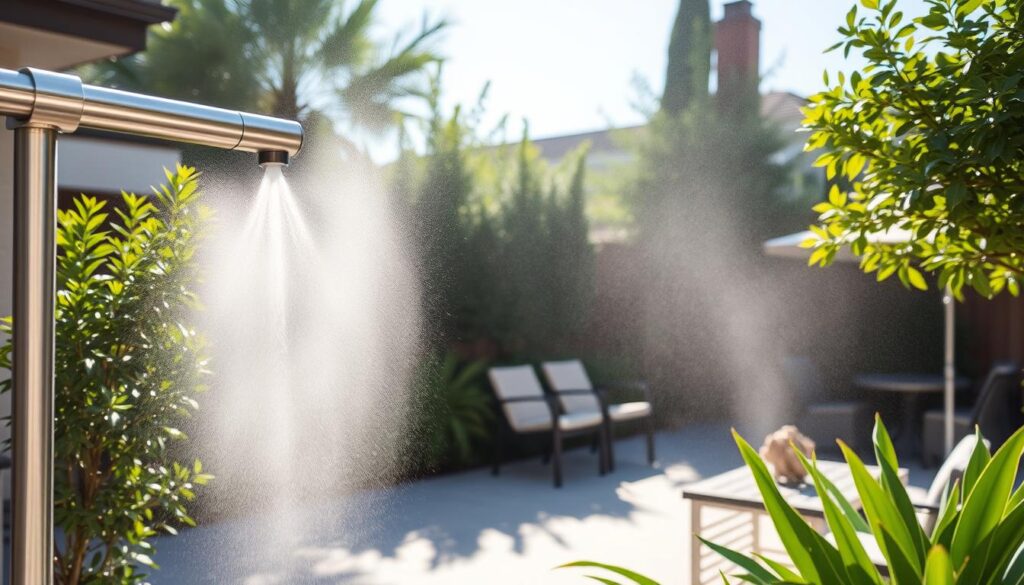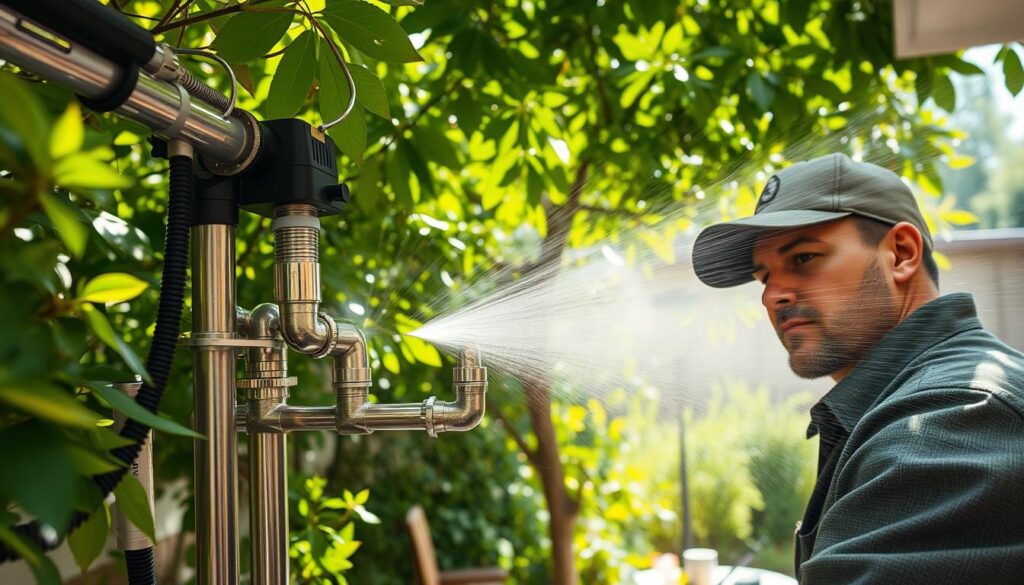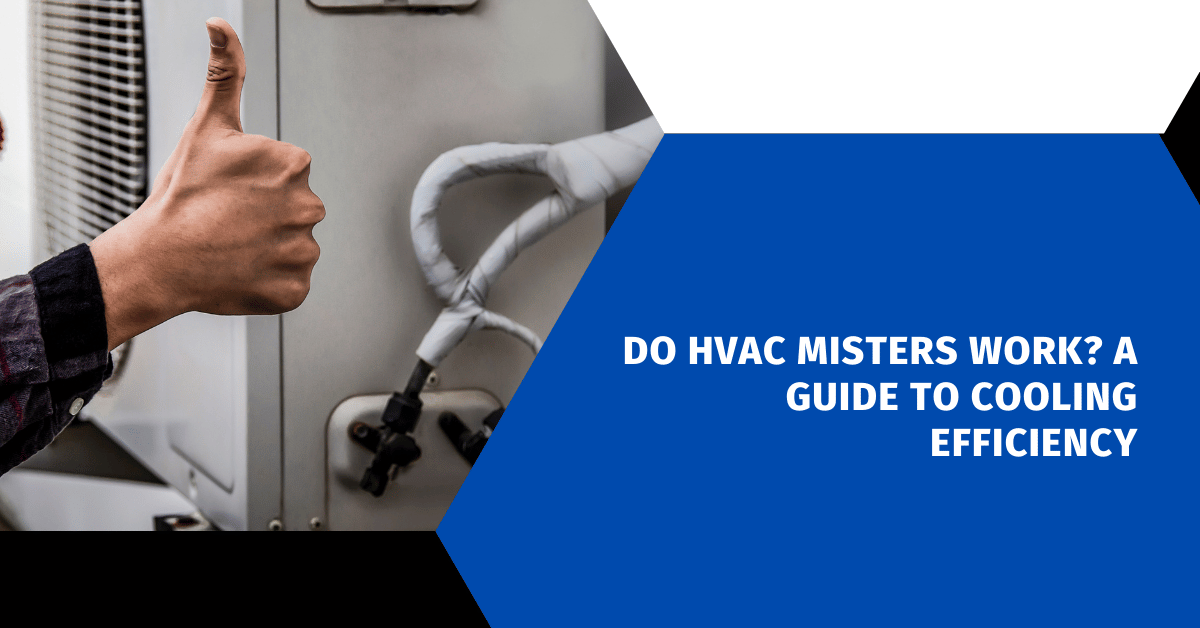Affiliate Disclosure
HVAC Guide Guys is a participant in the Amazon Services LLC Associates Program, an affiliate advertising program designed to provide a means for sites to earn advertising fees by advertising and linking to Amazon.
Do HVAC Misters Work? “The true secret of happiness lies in taking a genuine interest in all the details of daily life.” – William Morris
In the hot summer, people look for ways to cool their homes and businesses better. HVAC misting systems have become popular. They use water to cool the air around your AC, promising better cooling and lower bills. But do they really work? Let’s look into HVAC misting systems and see if they live up to their claims.

Key Takeaways
- HVAC misting systems use evaporative cooling to lower air temperatures around air conditioning units.
- The effectiveness of these systems varies depending on climate conditions and system design.
- Claims of significant energy savings should be viewed with skepticism, as real-world performance may not match manufacturer’s promises.
- Proper installation and maintenance are crucial for HVAC misting systems to function effectively and avoid potential issues.
- Homeowners should carefully weigh the benefits and drawbacks before investing in an HVAC misting system.
Table of Contents
Understanding HVAC Misting Systems: Basic Principles
HVAC misting systems use the science of evaporative cooling to cool the air. Water evaporating takes heat from the air, lowering its temperature. These systems have a water source, a pump, and misting nozzles that spray water droplets into the air.
How Evaporative Cooling Works
The cooling science is simple. Water turning into gas takes a lot of heat from the air. This makes the air cooler. For example, it takes a lot of energy to vaporize just a little water.
Components of HVAC Misting Systems
HVAC misting systems have a few main parts:
- Water source: This can be a municipal water supply, well, or recycled water system.
- Pressurization pump: This device increases the water pressure to the desired level, typically between 100-1,000 PSI.
- Misting nozzles: These specialized nozzles atomize the water into extremely fine droplets, often less than 10 microns in diameter, to maximize surface area and enhance evaporative cooling.
The Science Behind Temperature Reduction
The cooling power of HVAC misting systems depends on several things. These include water quality, nozzle design, water pressure, and humidity. In perfect conditions, they can cool the air by up to 30 degrees. Water is much better at cooling than air, making it efficient at absorbing and spreading heat.
| Statistic | Value |
|---|---|
| Water Vaporization Energy | 1 milliliter of water requires 2,260 kilojoules of heat energy to vaporize. |
| Droplet Size Comparison | Human hair is about 50 microns wide compared to fine mist droplets of less than 10 microns, which can take up to 15 minutes to reach the ground level from a height of 2.4 meters. |
| Misting Nozzle Droplet Size | Mistify misting nozzles produce droplet sizes around 4 microns. |
| Water Conductivity Comparison | Water conducts temperature 25 times more effectively than air. |
“Misting systems can reduce surrounding temperatures by up to 25 degrees.”
Do HVAC Misters Work: Effectiveness and Performance Analysis
HVAC misters, or “AC misters,” work differently in different climates. In dry, hot areas, they can cool the air well and make AC units work better. But, in humid places, they don’t cool as much.
Their performance also depends on water pressure, nozzle quality, and how close they are to the area they cool. These factors are key to how well they work.
Some say HVAC misters can cut energy bills by up to 20%. But, these claims need to be looked at closely. For example, water with lots of minerals can clog the system and make it less efficient over time.
| Factor | Impact on HVAC Mister Effectiveness |
|---|---|
| Climate | Dry climates: Significant cooling effect Humid climates: Reduced cooling impact |
| Water Pressure | Higher pressure: Improved atomization and cooling Lower pressure: Reduced cooling performance |
| Nozzle Quality | High-quality nozzles: Better water atomization and distribution Low-quality nozzles: Inconsistent cooling and potential clogs |
| Proximity to Cooling Area | Closer proximity: More effective cooling Farther distance: Reduced cooling impact |
| Water Quality | High mineral content: Increased scaling and reduced efficiency Low mineral content: Optimal performance and reduced maintenance |
In dry climates, HVAC misters can cool the air and make AC units more efficient. But, their success depends on many factors. Their ability to save money should be checked based on where they are used.
“Misting devices claim to potentially save up to 30 percent on energy bills when installed, indicating a significant potential for cost savings.”
Explore Our HVAC Shop
Looking for top-rated HVAC tools, parts, and accessories? Visit our shop and find the perfect solution for your needs.
Visit the ShopImpact of Climate and Humidity on Misting System Performance
The performance of HVAC misting systems depends a lot on the local climate and humidity. In dry areas, misting systems work well because water evaporates quickly, cooling the air a lot. But in humid places, the cooling effect is less because the air is already full of moisture.
Dry Climate Performance
In dry climates, misting systems do great because the air is not full of moisture. When water from the misting system evaporates, it cools the air a lot, sometimes by up to 30 degrees. This makes misting systems a cool and energy-saving way to cool down in dry areas, saving up to 50% on cooling costs.
Humid Climate Considerations
In humid areas, misting systems face a challenge because the air is already moist. The cooling effect is not as strong, and the system might not cool the air as much as hoped. To work well in these conditions, misting systems need more water and adjustments to keep the air cool.
Optimal Operating Conditions
For misting systems to work best, they need low humidity, high temperatures, and good air flow. The wet bulb temperature, which considers both temperature and humidity, should be much lower than the dry bulb temperature for cooling to work well. Keeping these conditions right is key to getting the most out of misting systems and saving energy.
“Misting systems can slash cooling costs by up to 50%, offering significant long-term savings for residential and commercial applications.”
| Climate Condition | Misting System Performance | Humidity Control Considerations |
|---|---|---|
| Dry Climate | Highly Effective | Minimal adjustments required to maintain optimal humidity levels |
| Humid Climate | Diminished Cooling Effect | Requires frequent adjustments and higher water output to maintain desired humidity |
Knowing how climate and humidity affect misting systems helps people make better choices. They can decide if misting systems are right for their place and how to use them best.
Explore Our HVAC Shop
Looking for top-rated HVAC tools, parts, and accessories? Visit our shop and find the perfect solution for your needs.
Visit the ShopEnergy Efficiency and Cost Savings Potential
HVAC misting systems can make your cooling more efficient and save money. Companies like Mistbox say you could cut cooling costs by 20-40%. But, how much you save depends on your location, system setup, and how you use it.
Thinking about getting an HVAC misting system? Remember the cost to install, upkeep, water use, and how it might affect your AC’s life. Sometimes, the system’s benefits might not last as long as you expect.
The Mistbox costs $450 and promises to save 20-40% on cooling. It’s supposed to pay for itself in one season and save thousands over its life. But, it uses about 32 gallons of water an hour, which costs around $50 a season.
AC costs vary by location and unit size. A 3-ton AC can cost $600 to $1600 a year. With a 20% savings, the Mistbox might take 27.5 years to break even. At 40% savings, it could take 13.8 years.
But, there are concerns. High outdoor humidity might not help the system’s efficiency. Lower AC use could raise indoor humidity. Also, dirt from outside could clog the AC coil, affecting performance.
“One large data center example saved $360,000 annually thanks to inexpensive airflow management measures.”
HVAC misting systems might save energy and money. But, it’s crucial to think about your specific situation. Make sure the benefits last longer than the costs.
Water Consumption and Environmental Impact
HVAC misting systems are great for cooling, but they use a lot of water. They can use up to 32 gallons of water per hour for a 3-ton air conditioner. This high water use is a big concern, especially in areas where water is scarce.
Water Usage Rates
The amount of water HVAC misting systems use is a big deal. They can use a lot of water, which can strain local water resources. This is especially true in areas with little water or during droughts.
Environmental Considerations
The environmental impact of HVAC misting systems goes beyond water use. There’s also the risk of water runoff and contaminants getting into local ecosystems. It’s important to install and maintain these systems properly to avoid these risks.
Water Quality Requirements
Keeping the water quality high is key for HVAC misting systems to work well. “Hard” water with minerals can cause scaling and reduce system efficiency. Having access to clean, high-quality water is crucial for these systems to work right.
As we look for ways to cool efficiently, we need to think about the pros and cons of HVAC misting systems. We must consider their water use and environmental impact. By understanding these, we can make choices that meet our cooling needs while being sustainable.
Explore Our HVAC Shop
Looking for top-rated HVAC tools, parts, and accessories? Visit our shop and find the perfect solution for your needs.
Visit the ShopInstallation Requirements and Considerations
Adding an HVAC misting system to your cooling setup needs careful planning. You must connect the water supply and meet electrical needs for the pumps. Each step is important for the system to work well and follow local rules.
Another key point is how the hvac mister setup fits with your current HVAC system. It’s vital to avoid any issues or harm to your equipment. Getting a pro to install it can help it work better and more efficiently.
Where you put the misting nozzles is also very important. They need to be in the right spot to spread the water mist well. You should think about air flow, the size of your unit, and the local weather.
| Key Considerations for HVAC Misting System Installation |
|---|
|
By focusing on these important steps, your HVAC misting system will work its best. It will cool your space well and save energy, whether it’s your home or a business.

“Proper integration with existing HVAC systems is crucial to avoid potential conflicts or damage.”
Common Issues and Maintenance Challenges
HVAC misting systems cool well but face maintenance hurdles. Mineral buildup and scale are big concerns, especially in hard water areas. These can block nozzles and cut efficiency, needing regular cleaning and descaling.
Homeowners worry about these systems shortening their HVAC’s life. Moisture can speed up corrosion, causing parts to wear out faster. This means more repairs and a shorter system life.
Preventive Maintenance Tips
To keep your HVAC misting system in top shape, regular care is vital. This includes:
- Regular nozzle cleaning to stop mineral buildup and keep water flowing right
- Winterizing the system in cold areas to shield it from freezing
- Getting professional HVAC checks to spot issues and fix or adjust as needed
By doing these maintenance tasks, you can make your HVAC misting system last longer. Enjoy its cooling for years. Remember, taking care of it now saves you from expensive fixes later.
“Proper maintenance is crucial for HVAC misting systems to operate effectively and efficiently. Neglecting these systems can lead to a variety of problems, from clogged nozzles to premature component failure.”
Explore Our HVAC Shop
Looking for top-rated HVAC tools, parts, and accessories? Visit our shop and find the perfect solution for your needs.
Visit the ShopComparing HVAC Misters to Alternative Cooling Methods
HVAC misters are an interesting choice for cooling homes or businesses. They might not work as well in humid areas. But they are great for saving energy and being kind to the environment.
HVAC misters can cut down on electricity use by up to 18%. This means big savings on bills and less harm to the planet. They also don’t use harmful chemicals, making them safe for families and pets.
Evaporative coolers, or “swamp coolers,” are similar to misters. But misters usually cool better, especially in dry places.
Using misters with natural cooling methods like shading and ventilation can make cooling even better. This mix can meet your cooling needs and save energy.
Choosing between misters and other cooling methods depends on your climate, budget, and what you prefer. Knowing the good and bad of each helps you pick the best for you and the planet.
| Cooling Method | Energy Efficiency | Cooling Effectiveness | Environmental Impact |
|---|---|---|---|
| HVAC Misters | 18% less electricity usage | Highly effective in dry climates | No chemicals, eco-friendly |
| Traditional Air Conditioning | Higher electricity consumption | Suitable for a wide range of climates | Uses chemical refrigerants |
| Evaporative Coolers | Moderate energy usage | Effective in dry climates | Water-based, environmentally friendly |
| Passive Cooling Techniques | Minimal energy usage | Supplementary cooling benefits | Sustainable, no emissions |

Looking into different cooling options helps you choose wisely. You can find the best fit for your energy goals, cooling needs, and environmental values.
Impact on HVAC System Lifespan and Performance
The debate on misting systems’ effect on HVAC lifespan and performance is ongoing. These systems might boost cooling efficiency in the short term. However, their long-term effects could be concerning. Moisture can cause corrosion and wear on AC parts, shortening the HVAC system’s life.
Mineral buildup from misting system water evaporation can also harm the system’s heat exchange efficiency. This decline in performance might cancel out the initial energy savings from misting technology.
It’s vital to consider both the benefits and drawbacks of misting systems. The climate, humidity, and water quality in your area are key factors. They help determine the long-term success and impact of an hvac system misting solution.
| Potential Benefits | Potential Drawbacks |
|---|---|
|
|
Choosing to use an hvac system misting system requires careful thought. You must weigh the benefits against the drawbacks. This ensures the HVAC system’s long-term sustainability and performance.
“Proper maintenance and monitoring of an HVAC misting system are crucial to ensuring its long-term viability and preserving the lifespan of the overall HVAC system.”
Explore Our HVAC Shop
Looking for top-rated HVAC tools, parts, and accessories? Visit our shop and find the perfect solution for your needs.
Visit the ShopPractical Applications and Best Use Cases
HVAC misting systems work best in hot, dry places. They are great for homes and businesses in dry areas. They also cool public spaces and industrial sites where it’s very hot.
These systems are best in places with low humidity and always hot weather. They help when regular ACs can’t keep things cool enough.
One big plus of HVAC misting systems is they cool the air before it hits the AC. This can save over 30% on energy. The misting system also makes the AC work less hard, saving money and keeping it running better.
- HVAC misting systems are highly effective in dry climates, providing significant cooling through evaporative cooling.
- They are well-suited for residential, commercial, and industrial applications where traditional AC systems struggle to maintain comfort levels efficiently.
- Misting systems can pre-cool the air before it enters the HVAC unit, resulting in energy savings of over 30%.
- The misting system helps reduce compressor head pressure, leading to lower running costs and improved performance.
Companies like OZmist have been making top-notch misting systems for over 20 years. They serve many industries, including data centers and hotels. Their systems use less water, saving on water bills.
HVAC misting systems are a smart choice for cooling in hot, dry places. They offer big benefits for many uses, from homes to big industrial sites.
Conclusion
HVAC misting systems can be very effective in saving energy and cooling spaces, especially in dry areas. But, their success depends a lot on the environment, how they’re set up, and keeping them in good shape.
Before choosing an HVAC misting system, think about your local weather, how much water you’ll use, and its effect on your HVAC. Also, consider if it’s worth the cost. Sometimes, regular air conditioning might be a better choice for you.
Deciding on an HVAC misting system needs careful thought. Know the good and bad points for your area. This way, you can pick the best option for your cooling needs, budget, and future plans.

